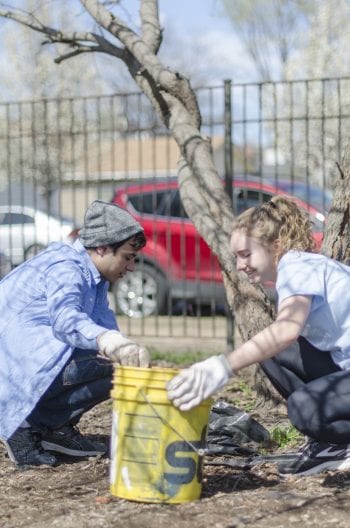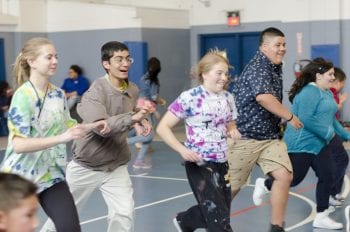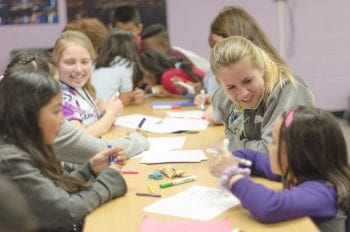
By Monica Lim and Michael Collins, Danforth Scholars Class of 2018
As fifteen students circled together in the living room of Rutger house, the warm breeze, carrying the steady swoosh of cars and dusky peace, filtered through the screen of the window. Being situated just a few blocks south of the Civic Center metro stop, the house could look onto the Gateway Arch, which carved out the right hand side of the scene. Between the Arch and Rutger house itself, layers of homes and schools, each with their unique challenges and triumphs, quieted the group gathered for reflection. Within this quiet, a student posed a question: “What does successful public housing look like?”
This question, and many others, framed the conversations for the Danforth Scholars’ service trip. Rather than spending Spring Break away, the Danforth Scholars chose to spend their annual service trip near home — experiencing St. Louis in ways that both challenged and inspired them. In the past, the service trips partnered with Habitat for Humanity. Last year’s trip took the group to New Orleans. While these experiences were meaningful, the scholars asked for a new model, one that would teach them about St. Louis and provide an anchor for their studies at WashU.
With those goals in mind, this year’s trip was modeled after the Urban Immersion experience developed by the Gephardt Institute. That is, students lived and learned in the communities, seeing the city “from a new, more nuanced perspective,” as freshman Nathaniel Bernstein said. Specifically, the scholars worked with organizations focused on homelessness and family services, based on feedback provided months before the trip itself.
The week started with a five-hour tour with Professor Bob Hansman, who provided the history, context, and experience necessary to understand today’s housing and education realities. Students were led through the historic site of Pruitt-Igoe and talked through some of the patterns that form the cyclical nature of poverty. Most importantly, Professor Hansman talked about community and often paused during the tour in order to catch up with people in the neighborhoods. After the week, freshman Maddie Farrer emphasized this passion for people:
“Stepping out of the Wash U bubble, walking the streets of impoverished neighborhoods, and talking to people who actually lived in the projects truly showed me that St. Louis is not made of just buildings, restaurants, an
d stadiums but relationships and connections between people.”
In the same vein, students were given the chance to talk over breakfast with many St. Louis natives and visitors at The Bridge Outreach. The following days involved cleaning a home with Beyond Housing and visiting a community movie theater. For some students, one of the most interesting aspects of the trip was seeing the Ask-Align-Act model in action, which Beyond Housing follows when implementing projects in communities. Lauren Berger, a junior, was amazed by the responsive approach taken by partner organizations: “In some ways, I think that the most important way we can start solving the problems in St. Louis is b
y simply sitting down with the adults and kids we meet in the community and start to learn their stories.”
Finally, the week ended with reflection, learning, and playtime with kids at Kingdom House, which is across the street from Rutger house. However, though the students said goodbye to the community and Rutger house on Friday, it is evident that the service will continue. Several students exchanged contact information with community partners, with individual plans to return to kids’ games or meals with the homeless. As one student reflected, “Life at WashU is vastly different from life for a resident of St. Louis in many of the neighborhoods that we visited and served. But that cannot keep WashU students out of the communities. We also need to recognize that we have a voice and choices that are not available to many St. Louis residents.”
Beyond this commitment to breaking the WashU bubble, this group of scholars is redefining and refreshing its commitment to community. Above all, what draws the Danforth Scholars together is this simple motto: “My own self, at my very best, all the time.” Throughout the week, this group showed how individuals at their very best can uplift a group of people, a school, a city. As seen in the faces of those gathered together in Rutger house, the learning and change does not end on spring break. Rather, to quote an age-old idea, to those have been given much, much is expected. As a group or individually or in whatever capacity this mosaic group of scholars possesses, the lessons learned on the trip will catalyze further growth and change in the WashU and St. Louis community . And that is something to look forward to.

